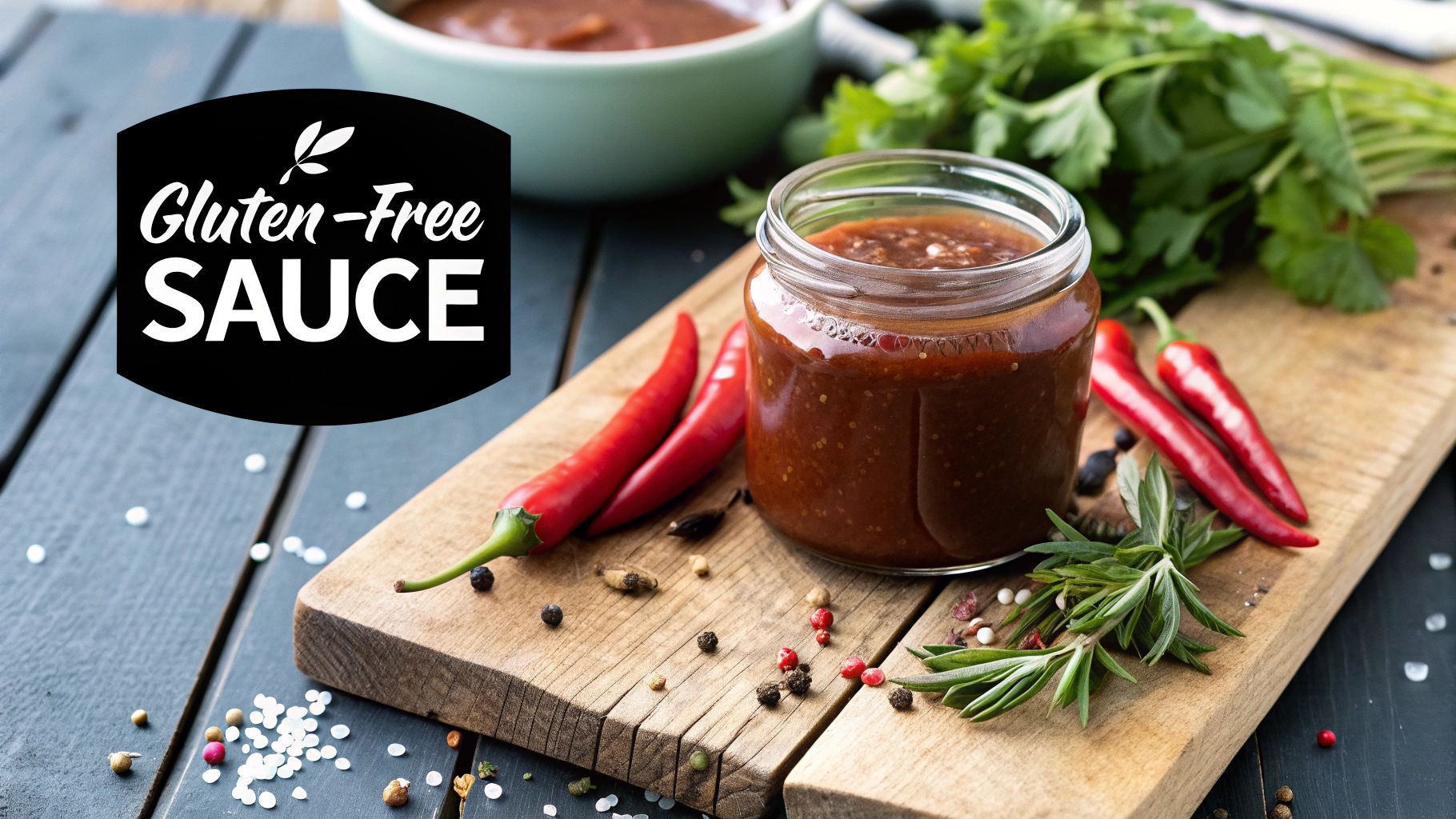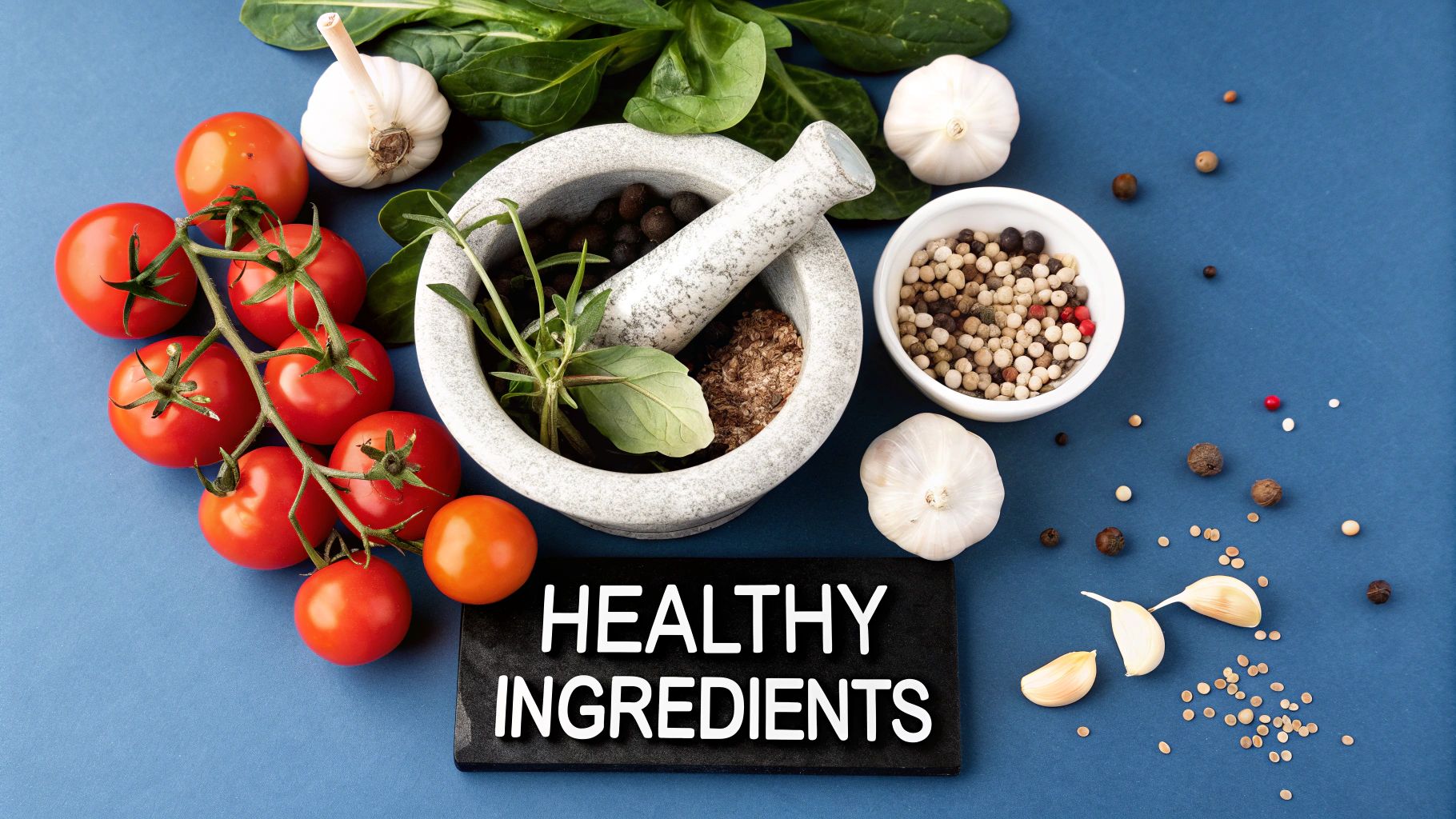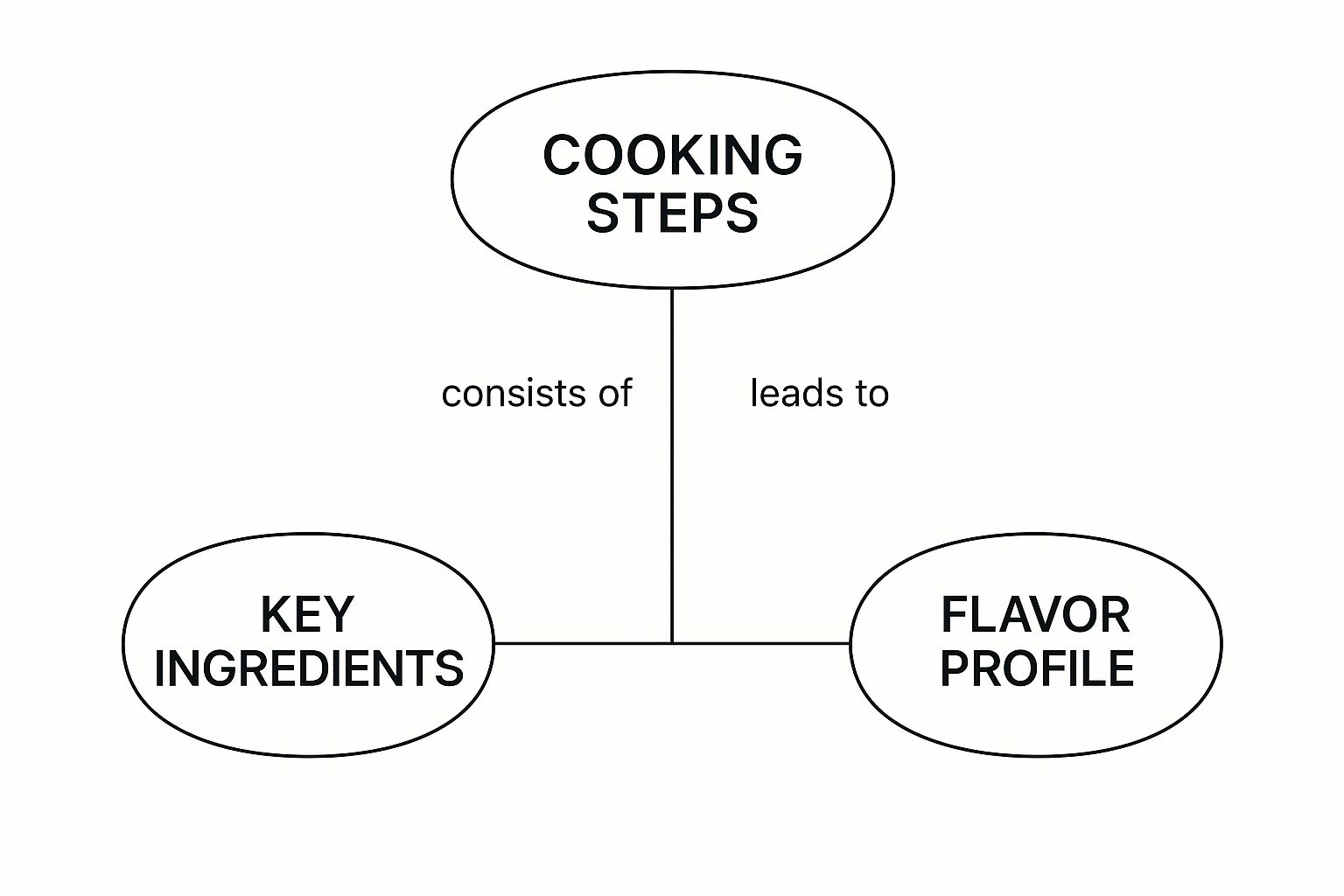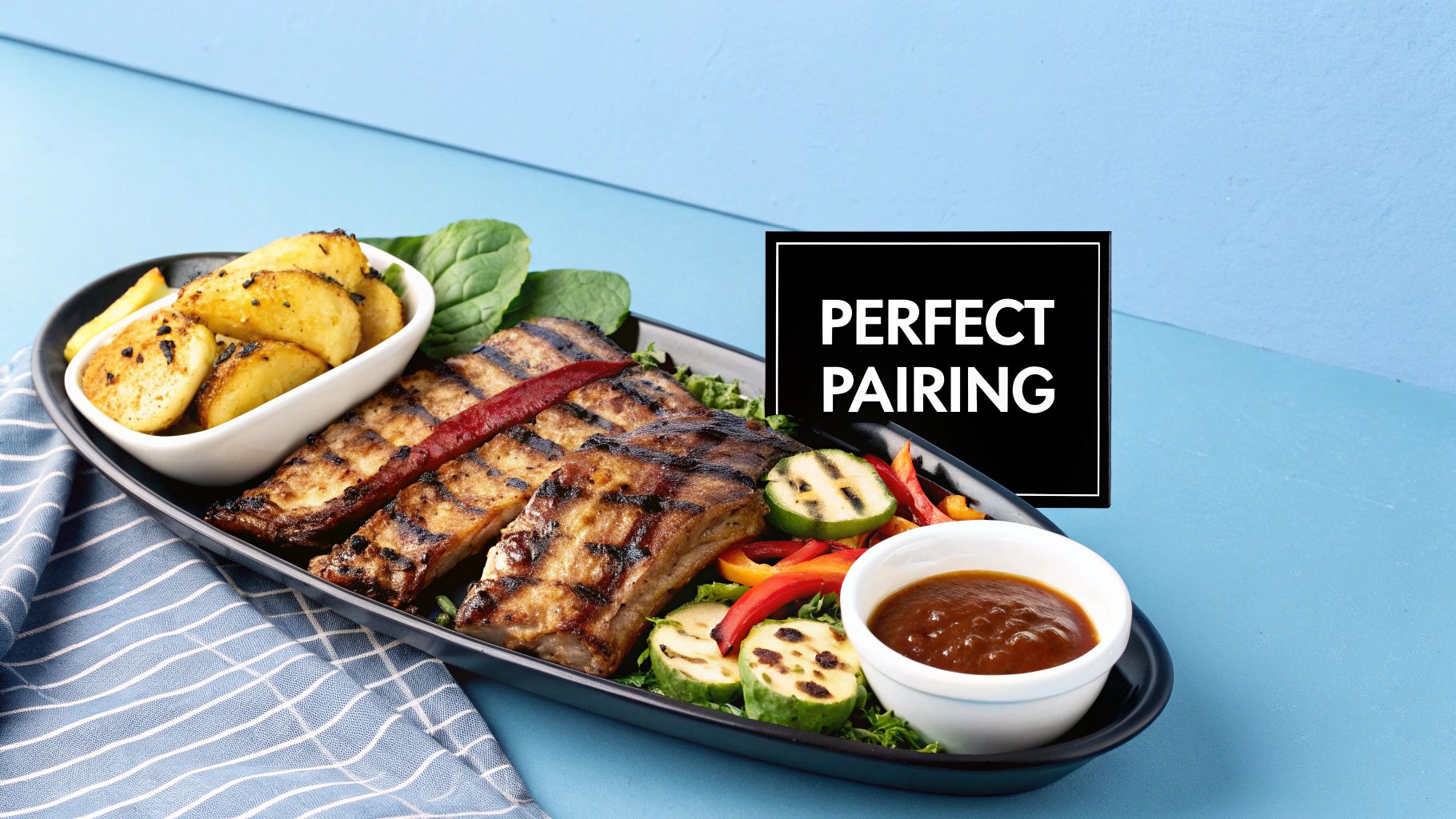Your Guide to Gluten Free Barbecue Sauce
Finding a great gluten free barbecue sauce shouldn't mean compromising on flavour. Whether you've got coeliac disease, a gluten sensitivity, or you're just cooking for friends and family, you deserve that classic smoky, tangy taste without the worry. A proper gluten-free sauce gets its flavour from high-quality, naturally safe ingredients—no hidden wheat, barley, or rye.
Your Essential Guide to Gluten Free BBQ Sauce

Let's be honest, hunting for a gluten-free BBQ sauce can be a minefield. What looks like a simple tomato-based sauce can easily hide things like wheat flour (a common thickener) or malt vinegar, which comes from barley. This guide is for everyone—from seasoned pitmasters to home cooks—who wants bold, authentic flavour without second-guessing what’s in the bottle.
Our mission here is to give you the confidence to pick the right sauce and create incredible food. We'll show you what makes a sauce genuinely gluten-free, how to read labels like a pro, and what to watch out for. It’s not just about avoiding an ingredient; it’s about understanding your food so you can serve up delicious, safe meals every single time.
Why This Guide Matters Now More Than Ever
The demand for good-quality, gluten-free food has exploded. It's not just a niche market anymore. In fact, the UK gluten-free market was valued at around USD 243 million in 2023 and is expected to hit USD 478 million by 2032. This isn’t surprising when you consider that coeliac disease affects roughly 1 in every 100 people in the UK, and many more are dealing with gluten intolerance.
At Smokey Rebel, we don’t see this as a trend. We see it as a fundamental need for better, more honest food. Our "no added crap" philosophy means we make our sauces with real ingredients, so they’re naturally gluten-free without ever sacrificing the deep, complex flavours you’re looking for.
This guide will give you the practical knowledge you need, from spotting hidden gluten on an ingredients list to mastering cooking techniques. We'll cover:
- Common places gluten hides in popular sauces.
- Simple tips for spotting certified gluten-free products.
- Step-by-step uses for gluten free barbecue sauce on ribs, pulled pork, and chicken.
- How our range of Smokey Rebel gluten free BBQ sauces delivers authentic flavour, guaranteed.
Why Gluten Hides in Your Barbecue Sauce

It seems odd, doesn't it? A proper barbecue sauce should just be tomatoes, vinegar, and a killer spice blend. So where does the gluten come from? The answer usually boils down to shortcuts and cost-cutting.
A lot of mass-produced sauces use gluten-packed ingredients as a cheap and easy way to get that thick texture and deep, savoury flavour we all love. Think of it as a quick fix. Instead of simmering the sauce for hours to let it thicken naturally, they'll just chuck in some wheat flour or modified food starch. It does the job, but it's a cheat.
This means that while the headline ingredients are gluten-free, these sneaky additives can turn a perfectly good sauce into a nightmare for anyone with coeliac disease or gluten sensitivity. Knowing what to look for is the first step to finding a sauce that's both safe and genuinely delicious.
The Most Common Gluten Culprits
When you're scanning an ingredients list, a few words should set off alarm bells. These are the usual suspects that sneak gluten into barbecue sauce, often hiding in plain sight. Learning to spot them makes shopping a whole lot easier.
Here are the main sources of hidden gluten to watch out for:
- Malt Vinegar: A classic flavour, sure, but it's made from barley—a major gluten grain. It adds a specific tangy kick, but it’s a definite no-go.
- Wheat Flour or Starch: As we said, this is the number one thickener. If you see "wheat," "flour," or "starch" without a clear source (like corn or potato), it’s best to assume it's wheat-based and move on.
- Soy Sauce: Your standard soy sauce is brewed with fermented wheat to give it that deep umami hit. Unless the label specifically says "tamari" or "gluten-free," you can bet it contains wheat.
- Beer: Some of those "beer-infused" sauces get their flavour from stout or ale. Since most beer is made from barley or wheat, these are off the table.
- "Natural Flavourings" or "Spices": This one is a bit tricky. It’s rare, but sometimes gluten-containing additives like wheat-derived maltodextrin can be lumped under these vague terms.
Keep these culprits in mind, and you'll be able to filter out the bad stuff in seconds. No more wasted time, and no more accidental gluten exposure.
The Smokey Rebel Approach: No Added Crap
So, how do you get a thick, rich, and ridiculously flavourful gluten free barbecue sauce without taking shortcuts? At Smokey Rebel, our way is simple: just use better ingredients in the first place. We reckon authentic flavour doesn't need cheap fillers.
Our 'no added crap' promise means we never touch wheat flour or malt vinegar. We get that perfect consistency the old-fashioned way—by slow-simmering our sauces and using a killer blend of authentic cultural flavours from real ingredients like tomato puree, spices, and natural sweeteners. The result? A sauce that’s naturally thick and bursting with proper flavour.
Instead of bog-standard soy sauce, we build that umami depth with carefully chosen spices. Instead of barley-based vinegar, we use alternatives that deliver the right tang without the gluten. It's this commitment to real craft and quality that sets us apart.
Our sauces, packed in their signature craft cans, are proof that you never have to compromise on taste to get a safe, genuinely gluten-free product.
How to Become a Gluten Free Label Detective
Right, so you've seen a bottle that looks the part, but the big "gluten-free" logo is nowhere in sight. What now? This is where you learn to look past the marketing on the front and get to the truth on the back.
Learning to scan an ingredients list is a proper skill. It’s like looking under the bonnet of a car before you buy it – you need to know what’s really going on in there. We'll show you how to spot the hidden gluten that catches so many people out and make sense of those confusing allergen warnings.
This is how you go from just hoping for the best to choosing the right gluten free barbecue sauce with total confidence.

As you can see, everything comes back to the ingredients. You can’t get a genuinely great flavour without starting with genuinely great stuff.
Decoding the Ingredients List
When you flip that bottle over, remember ingredients are listed from most to least. The first five to seven are usually the most important – that’s where you’ll find the base ingredients and any sneaky thickeners.
You want to see clear, honest ingredients like "tomato puree," "apple cider vinegar," and "smoked paprika." Those are green flags. It's the vague, science-y sounding terms that should make you suspicious.
Here are the main culprits to keep an eye out for:
- Malt Flavouring or Extract: If you see this, put the bottle down. It’s almost always made from barley, which is a definite no-go.
- Hydrolysed Wheat Protein: Just another name for gluten. It's sometimes chucked in for a savoury, umami hit. Avoid.
- Brewer's Yeast: This is often a by-product of making beer, so it’s likely to be contaminated with wheat and barley. It’s a risky one.
- Modified Food Starch: This one’s tricky. If it doesn’t say where it comes from (like "modified corn starch"), it could be from wheat. UK law says they have to declare wheat, but it’s still one to be wary of.
The goal isn't just to find a sauce that happens to be gluten-free. It's about finding one that was made from the ground up with quality, naturally gluten-free ingredients. That’s the whole idea behind our "no added crap" promise.
Navigating Allergen Warnings
Underneath the main list, you’ll find the allergen warnings. For anyone with coeliac disease, this is the most important bit.
A "may contain wheat" warning is a deal-breaker.
It means the sauce was made in the same place or on the same equipment as products containing wheat. Even if the recipe is clean, the risk of cross-contamination is real. If you’re highly sensitive or coeliac, you have to give it a miss.
To help you out in the supermarket aisle, here’s a quick guide to spotting the good stuff from the bad.
Hidden Gluten Ingredients vs Safe Alternatives
This table breaks down some of the most common gluten-containing ingredients you'll find hiding in barbecue sauces, and shows you the safe alternatives to look for instead.
| Common Gluten-Containing Ingredient | Potential Source | Safe Gluten-Free Alternative |
|---|---|---|
| Wheat Flour | Used as a cheap and easy way to thicken up a watery sauce. | Look for sauces using cornflour, potato starch, or xantham gum. Even better, pick one that's naturally thick from being slow-simmered with real ingredients. |
| Malt Vinegar | A tangy vinegar made from barley, which brings gluten along with it. | Apple cider vinegar, distilled white vinegar, or rice vinegar all provide that sharp tang without any of the risk. |
| Soy Sauce | Traditional soy sauce is brewed with wheat to create its classic umami flavour. | Tamari is a fantastic alternative made with little to no wheat. Coconut aminos are another great option for that savoury depth. |
| "Natural Smoke Flavour" | This can sometimes have barley malt flour mixed in as a carrier ingredient. | Check for sauces that use "liquid smoke" or get their flavour from naturally smoked spices like paprika for an authentic taste without the hidden nasties. |
Armed with this knowledge, you can spot the imposters and pick a sauce that's all flavour, no fillers.
Cooking with Gluten Free BBQ Sauce

Right, let’s get to the good bit – moving from the supermarket aisle to the grill. Having a top-quality gluten free barbecue sauce in the cupboard is one thing, but knowing how to turn it into a jaw-dropping meal is where the real magic happens.
This is all about getting your hands dirty. We'll give you foolproof mini-guides for some absolute BBQ classics, showing you exactly how to get that perfect, sticky, smoky finish. No abstract theories here, just simple steps to make food that disappears in minutes.
How to Glaze Gluten Free Ribs to Perfection
There’s nothing like a rack of perfectly cooked ribs, dripping with a sticky, caramelised glaze. The secret isn't complicated; it's all about timing. Slathering on the sauce too early is a rookie mistake that leaves you with a burnt, bitter mess instead of that sweet, smoky crust we’re all chasing.
Here’s a simple, foolproof method for perfect seasonings for bbq ribs:
- Prep Your Ribs: Grab your favourite cut of pork ribs. Pat them dry and, for extra tender results, slide a knife under the thin membrane on the bone side and peel it off.
- Apply a Dry Rub: Before they see any heat, season them generously with a quality gluten-free BBQ rub. This is your foundation of flavour.
- Cook Low and Slow: Whether you're using an oven, smoker, or grill, indirect heat is your friend here. Cook the ribs low and slow – around 135°C (275°F) – until they’re tender and the meat has started to pull back from the bone.
- The Glazing Stage: This is the crucial part. For the final 20-30 minutes of cooking, start brushing on your sauce. Apply a thin layer of a quality gluten-free option like our Rebel BBQ Sauce, let it set for 10 minutes, then go again. Repeat this two or three times to build a beautiful, glossy glaze that doesn’t burn.
This layering technique is what ensures the sugars in the sauce caramelise perfectly without scorching. It’s how you get that signature shiny, finger-licking finish that makes BBQ ribs so damn good. Your cooking method is key, and you can even explore various charbroiling techniques for that perfect smoky touch.
Making the Ultimate Gluten Free Pulled Pork
Pulled pork is a true crowd-pleaser, perfect for feeding the family or a garden full of mates. A great gluten free barbecue sauce is non-negotiable here, as it not only adds massive flavour but also keeps the meat juicy and tender. For this one, the slow cooker is your best friend.
Here’s how to create the best seasonings for bbq pulled pork:
- Season the Pork: Get yourself a boneless pork shoulder (sometimes called a Boston butt). Pat it dry and rub it all over with your chosen gluten-free seasoning.
- Sear for Flavour: You can skip this if you’re short on time, but searing the pork shoulder in a hot pan on all sides before it goes into the slow cooker adds a much deeper, richer flavour. Trust me, it’s worth it.
- Slow Cook to Tenderness: Pop the pork in your slow cooker and pour about half a cup of liquid around it – apple cider vinegar or a simple broth works wonders. Cook it on low for 8-10 hours, or until it’s literally falling apart.
- Shred and Sauce: Lift the pork out and shred it with two forks. Ditch any excess liquid left in the pot, then tip the shredded pork back in. Now for the main event: stir in your gluten free barbecue sauce until all the meat is coated. Start with about a cup and add more until it’s just how you like it.
2-Minute BBQ Chicken Thighs for the Air Fryer
Need a quick, flavour-packed meal? The air fryer is your secret weapon for incredible BBQ chicken. This is how you get juicy, flavourful chicken in minutes, perfect for a weeknight dinner.
- Season the Chicken: Take 4-6 boneless, skinless chicken thighs and pat them dry. In a bowl, toss them with 1 tablespoon of olive oil and a generous amount of your favourite gluten-free bbq seasonings for chicken. Make sure they're fully coated.
- Air Fry: Place the seasoned thighs in the air fryer basket in a single layer. Cook at 200°C (400°F) for 15-18 minutes, flipping them halfway through.
- Sauce and Finish: In the last 2 minutes of cooking, open the air fryer and brush the thighs liberally with your gluten free barbecue sauce. Close and cook for the final 2 minutes until the sauce is bubbly and slightly caramelised.
These simple methods prove that cooking incredible, family-friendly meals that are both safe and packed with authentic BBQ flavour is easier than you think. All you need are the right ingredients and a little know-how.
The Smokey Rebel Difference: Flavour Without Compromise
In a world full of shortcuts, we believe some things should be done the right way. When it comes to our gluten-free barbecue sauce, our "no added crap" promise isn't just a catchy phrase on the can; it's the foundation of every recipe we create. It’s our commitment to you, to flavour, and to honest, real food.
Many mass-market brands rely on cheap fillers and shortcuts to get the texture or flavour they want. You'll often find wheat flour used as a thickener or malt vinegar for a quick, one-note tangy hit. We just don't do that. We believe authentic flavour comes from authentic ingredients, not from a lab.
Craftsmanship in a Can
Our approach is simple: we use real ingredients to create real flavour. Instead of gluten-based thickeners, our sauces get their rich consistency from being slow-simmered. This process allows the natural sugars in the tomatoes to caramelise and the spices to meld together perfectly, building a deep, complex flavour you just can't fake.
This philosophy is about more than just avoiding gluten. It’s about creating a product that’s bursting with vibrant, authentic cultural flavours. We draw inspiration from our travels and a genuine love for food, carefully balancing spices to deliver a taste experience that’s bold and memorable. It’s a craft approach that stands apart from the punk or purist tones of other brands.
The Smokey Rebel story is about connecting our passion for quality with the safety and flavour you taste in every bite. Our distinctive craft can packaging isn’t just for show—it reflects the premium, vibrant, and carefully crafted product inside.
Aligning with Modern Tastes
Our commitment to clean, real ingredients is exactly what modern food lovers are looking for. People are more conscious than ever about what they eat, seeking out products that are not only delicious but also fit a healthier, more mindful lifestyle.
You can see this trend loud and clear in the UK, where the organic gluten-free food segment is projected to grow at an impressive 9.65% annually through 2030. It's being driven by younger consumers who link gluten-free choices with broader health and environmental goals. Choosing a high-quality gluten-free barbecue sauce is becoming part of a much bigger movement towards better eating. You can read more about the UK's growing demand for organic gluten-free options.
Choosing Smokey Rebel means you’re not just getting a sauce; you’re getting a product born from a genuine passion for great food. Every can is a promise of quality, safety, and unforgettable flavour, made for families and flavour pioneers who refuse to settle for second best. Discover more about our story and commitment to real ingredients.
FAQs: Your Gluten Free BBQ Questions Answered
We’ve covered a lot of ground, from decoding labels to nailing your glazing technique. But let’s get down to the nitty-gritty. Here are the questions that always pop up when you're hunting for a genuinely great gluten free barbecue sauce.
Think of this as your quick-fire FAQ for all things gluten-free BBQ.
Is most barbecue sauce in the UK gluten free?
In a word? No. It’s a common trap to fall into. While there are more gluten-free options on the shelves than ever before, you really can’t assume the bottle you grab is safe. Many big-name brands still rely on gluten-packed ingredients as cheap shortcuts for flavour and thickness. The usual suspects are malt vinegar (made from barley) and plain old wheat flour. Your safest bet is always to look for a clear "Certified Gluten-Free" logo or choose a brand committed to a "no added crap" philosophy.
What is a good gluten free substitute for soy sauce?
When a recipe calls for that deep, savoury umami kick of soy sauce, you’ve got a couple of brilliant gluten-free alternatives. The best like-for-like swap is Tamari, a Japanese-style soy sauce made with very little or no wheat. Another fantastic option, especially if you need a soy-free sauce too, is coconut aminos. It brings a similar savoury taste with a hint of natural sweetness, perfect for building flavour in a homemade gluten free barbecue sauce.
Can I make my own gluten free BBQ sauce at home?
Absolutely! Making your own sauce is simple and gives you total control over the flavour. Start with a base of tomato puree, add sweetness with brown sugar or maple syrup, tang with apple cider vinegar, and depth with smoked paprika and gluten-free Tamari. Simmer it all in a saucepan for 20-30 minutes to let the flavours meld and the sauce thicken. It's the best way to create a signature sauce that’s 100% you.
Are Smokey Rebel sauces safe for coeliac disease?
Yes, they are. Our 'no added crap' philosophy isn't just a slogan—it's our promise. We craft our entire range to be gluten-free from the ground up, making them completely safe for anyone with coeliac disease. We build our bold, signature profiles with naturally gluten-free ingredients like authentic spices and rich tomato puree. You can enjoy the authentic, punchy flavours of Smokey Rebel with total peace of mind.
Ready to taste what real ingredients can do? Explore the full range of bold, authentic, and naturally gluten-free sauces from Smokey Rebel and find your new family favourite.
Join our Mailing List
Sign up and get Smokey Rebel Recipes + weekly recipes straight to your inbox!
Recent articles
Your Guide to Gluten Free Barbecue Sauce
Discover which ingredients to avoid and find your new favorite gluten free barbecue sauce. Learn to read labels and make...
Read moreEasy Homemade BBQ Sauce Gluten Free Recipe
Discover how to make a rich, smoky bbq sauce gluten free from scratch. This guide offers an easy recipe, key...
Read moreThe Ultimate Guide to Spices Gift Sets for Food Lovers
Discover the best spices gift sets for every cook. Our guide helps you choose the perfect BBQ rubs and seasonings...
Read more


